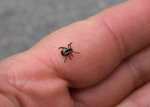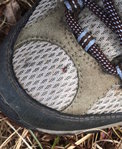 Narrowsburg
NarrowsburgLight Rain Fog/Mist, 43°
Wind: 8.1 mph
 Narrowsburg
NarrowsburgIt’s time to talk about ticks. For starters, May is National Lyme Disease Awareness Month, and the vexatious miniature vampires that are vectors of Lyme disease are out in full force.
Over …
Stay informed about your community and support local independent journalism.
Subscribe to The River Reporter today. click here
This item is available in full to subscribers.
Please log in to continue |


It’s time to talk about ticks. For starters, May is National Lyme Disease Awareness Month, and the vexatious miniature vampires that are vectors of Lyme disease are out in full force.
Over the past few weeks, outdoor activities have enabled multiple ticks to explore the possibility of a blood meal from me or my dogs. Thankfully, none have succeeded so far! But just now, as I was writing this column, a tick began crawling up my clothing, seeking sustenance following a forest walk with the pups. The war is on!
Lyme disease is a bacterial infection transmitted primarily through the bites of infected deer ticks (Eastern black-legged ticks). It poses serious health threats, and Pennsylvania continues to rank first in the U.S. in reported cases of Lyme disease, which increase every year. The Pennsylvania Department of Environmental Protection has reported Lyme and other tick-borne diseases in all 67 counties.
In Pennsylvania, Pike County’s Tick Borne Diseases Task Force has shared the results of a first-of-its-kind baseline study it conducted from 2018 to 2019 in partnership with the Dr. Jane Huffman Wildlife Genetics Institute at East Stroudsburg University.
The tick task force is an initiative of the Pike County Commissioners focused on decreasing the number of tick-borne illnesses by building community awareness through education, support and advocacy. In 2019, its efforts were recognized with an Environmental Partnership Award from the Northeast Environmental Partners.
The baseline study involved the collection and testing of 1,000 black-legged ticks for seven disease-causing organisms that the ticks may carry. The intent was to assess disease and infection rates in order to provide educational outreach to the public and medical professionals on risks and prevention of tick-borne diseases.
In total, 1,051 black-legged ticks and 1,003 dog ticks were collected, as well as one lone star tick and one Asian longhorn tick. The black-legged ticks collected were tested for Lyme disease, anaplasmosis, babesiosis, bartonellosis, mycoplasmosis, miyamotoi and Powassan virus lineage II.
Lyme disease was the most pervasive finding, with 38.77 percent of the ticks testing positive, followed by 18.52 percent of ticks testing positive for Bartonellosis. There were 123 ticks found to be carrying two or more diseases, known as a co-infection. The highest co-infection observed was Lyme disease and anaplasmosis.
Pike County’s tick task force offers educational brochures to help people prevent tick-borne diseases. The Tick 101 brochure covers identification, removal, symptoms, testing facilities and prevention techniques. Tick 201 provides proactive measures to help protect your property and includes a refresher on tick identification and testing. Educational materials for children include a short story, lessons and activity sheets.
The task force meets on the fourth Thursday of each month at 10 a.m. via Zoom, and new members are welcome. For more information on the study’s results, visit the task force website at www.pikepa.org/tick or contact Brian Snyder at bsnyder@pikepa.org or 570/296-3500.
In addition, the PA Lyme Resource Network was awarded a grant for creation of an interactive tick check song to help educate and protect children. Kids of all ages (adults included!) can take the #TickCheckChallenge by recording themselves performing their version of a proper tick check to the beat of children’s musicians Louis & Dan and the Invisible Band’s fun and informative song. Visit www.palyme.org to learn more and to sign up for “Lyme Bytes” filled with regional spotlights, support group listings, tips and tools, research updates, legislative action and advocacy efforts.
Comments
No comments on this item Please log in to comment by clicking here